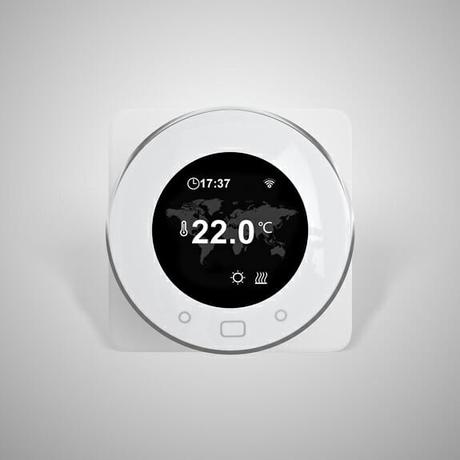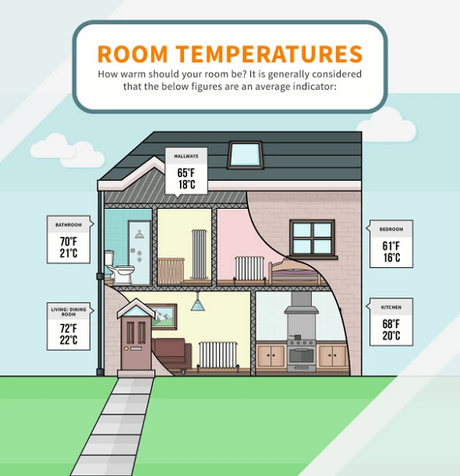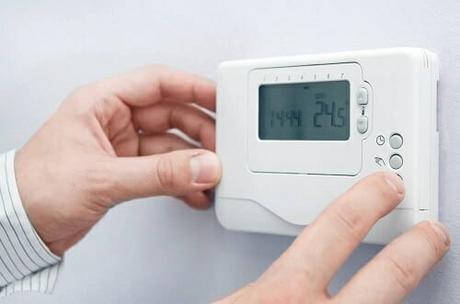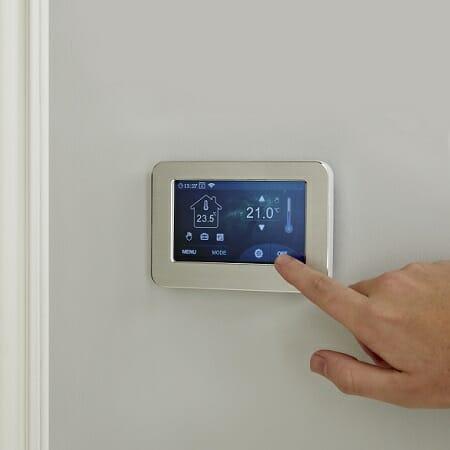Where To Position A
Central
Heating
Thermostat
When it comes to choosing the best place to position a central heating thermostat there are a few general dos and don’ts that can affect how well your heating system works.
Obviously, you DO want to put it in as convenient a place as possible, but you DON’T want to position a thermostat in a spot that could potentially cost you money and see your home’s heating work overtime.
So we’ve put together this quick guide to help you make sure your thermostat is in just the right spot to do its job properly.
But first, what are central heating thermostats and how do they work?
What Is A Central Heating Thermostat?

A central heating thermostat is a set of controls used to regulate the output of your heating system, to make sure a comfortable temperature is maintained.
Heating thermostats work by monitoring the average temperature of your home and sending a signal to a boiler to ensure it’s never too hot or too cold.
You can manually set the temperature to a level you like and the thermostat will click into operation to get it there, and when that temperature has been achieved the thermostat will switch off the heating to ensure it doesn’t go above the level you selected.
If the temperature of your home drops, the thermostat kicks back in to inform the boiler it needs to fire up and raise it again.
Since thermostats sense the ambient temperature, their position is very important, because external factors could affect the temperature of a room and give a false reading.
So where should and shouldn’t your thermostat be positioned?
What’s The Best Place To Position A Thermostat?
Do Place Your Central Heating Thermostat
- On an interior wall
Placing your thermostat on an interior wall will give a more accurate reading because they are a better indication of the average temperature of your home.
External walls are often much cooler, so the thermostat will tell the boiler to warm the house up when it might not need to.
- In a frequently used room
We all want the rooms that we use the most to be at the most comfortable temperature.
So it makes sense to install the thermostat in a frequently used space like the living room so that it is just the right temperature all year round.
- Near the center of your home
As we mentioned earlier, the thermostat measures the average temperature of your home. And what is another word for average? Middle or centre!
So the middle of your home will give you the most accurate average reading since it will measure the centrally circulating air.
- 5ft above the floor
Heat rises, so if your thermostat is very high up the wall it will give you an inflated reading and tell your boiler to cool the house down.
About 5ft above the floor is the most common place to install your thermostat for an accurate average reading.

It is a good idea to avoid placing your thermostat in the following areas as these volatile zones are subject to other heat sources and extreme temperature variations.
Don’t Place Your Central Heating Thermostat
- Above a radiator
- In direct sunlight
- In the kitchen
- Near windows or doors
- In the hallway
- Above air vents
Whether it’s a cold draft from the front door or a blast of heat from the oven, a consistently up and down temperature will confuse your thermostat meaning your home won’t reach the comfortable set temperature and could potentially waste energy.
Should The Thermostat Be In The Coldest Room?
We would not advise putting the thermostat in the coldest room as this would not be a true reflection of the temperature of the rest of the house.
You want an average reading for it to work efficiently so placing it in the coldest part of the house would be an extreme cold air temperature zone to avoid.
If the thermostat senses cold, it will think that your entire home is just as cold. So it will tell your boiler to work harder which could increase your heating costs.
For the same reason, the thermostat shouldn’t be placed in the hottest part of the house.
Putting the thermostat in a very warm room tells the sensor that the house is too warm and so the boiler turns the heating down when you might not want it to.

Should The Thermostat Be Upstairs Or Downstairs?
Since heat rises, the upstairs rooms will often feel warmer than the downstairs rooms.
So an upstairs thermostat might think your entire home is getting too warm and start cooling it down.
Instead, we would advise placing your thermostat in a centrally located downstairs space that is used often, like the living room.
What About TRVs?

TRVs, also known as Thermostatic Radiator Valves, do a similar job to your room thermostat, hence their name.
So, if you do have TRVs in individual rooms, you will need to avoid placing your thermostat in the same room as them – or at the very least quite far apart.
This is to ensure that they don’t compete with each other to increase or decrease the temperature.
Take a look at our guide to installing TRVs to learn more.
What temperature should I set my thermostat in winter?
During winter time in the UK, most people set their central heating thermostat to 20°C. This will make sure that your home is comfortable and warm throughout the coldest time of the year.
Where Should A SMART Thermostat Be Positioned?
If you have a SMART Thermostat, make sure it is positioned in range of your Wi-Fi and that it has a strong connection.
Also, keep it out of the way of anything that might block the sensors such as behind a door or cabinet.
Need some more info on energy efficient SMART Heating? Head over to our ultimate guide to SMART home heating controls
Things To Remember

So, after all that technical thermostat talk let’s go over the bits you need to remember to control your heating effectively.
There are 4 key points to remember when choosing where to position a central heating thermostat –
- Place it in the center of your home.
- On an interior wall.
- Aim to position it about 5ft above the ground.
- In a room that you use a lot.
If you find the sweet spot, your thermostat will consistently give an accurate average reading to ensure your central heating system runs efficiently and keeps your entire home at a comfortable temperature.


